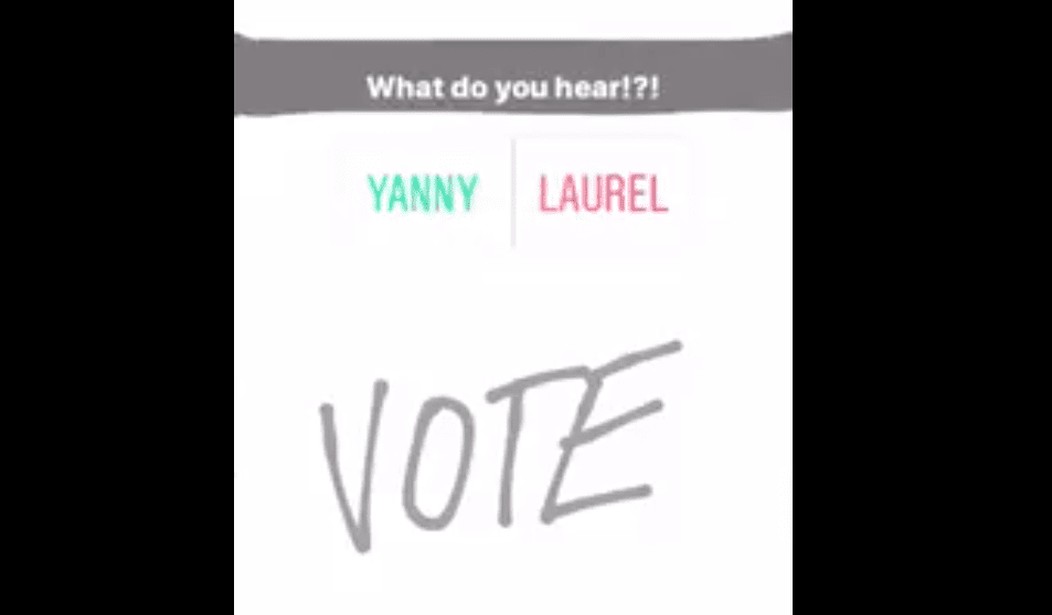An audio recording is taking the Internet by storm, dividing listeners into two camps: “Laurel” and “Yanny.” The audio is the same, but people hear different things. Sometimes, a listener hears “Laurel” first, and then “Yanny” later — from the same clip! Listen to it below.
What do you hear?! Yanny or Laurel pic.twitter.com/jvHhCbMc8I
— Cloe Feldman (@CloeCouture) May 15, 2018
Vote here: which did you hear?
Important poll: Do you hear "Laurel" or "Yanny"? https://t.co/7LsJH1r9Mo @PJMedia_com #Trending
— Tyler O'Neil (@Tyler2ONeil) May 16, 2018
The Twitter video with this audio has received nearly 10 million views, and celebrities have shared their experiences.
“It’s Yanny,” tweeted bestselling author Stephen King.
It’s Yanny.
— Stephen King (@StephenKing) May 16, 2018
Model Chrissy Teigen emphatically disagreed. “It’s so clearly laurel. I can’t even figure out how one would hear yanny.”
it's so clearly laurel. I can't even figure out how one would hear yanny.
— christine teigen (@chrissyteigen) May 15, 2018
Actress and LGBT activist Ellen DeGeneres said, “I hear Laurel.”
Literally everything at my show just stopped to see if people hear Laurel or Yanny. I hear Laurel. https://t.co/efWRw1Gj0L
— Ellen DeGeneres (@TheEllenShow) May 15, 2018
British celebrity Piers Morgan also weighed in, tweeting, “UPDATE: My wife also hears ‘Yanny’. So that’s both my wives, on screen & off, who are nuts. It’s LAUREL, ffs.”
UPDATE: My wife also hears 'Yanny'. So that's both my wives, on screen & off, who are nuts.
It's LAUREL, ffs. https://t.co/BWJbjXoBBZ— Piers Morgan (@piersmorgan) May 16, 2018
Liberal comedian Stephen Colbert shared his experience, hearing “Yanny,” then “Laurel,” then “Yanny” again.
5:30 – Yanny 9:30- Laurel What…is…happening?
— Stephen Colbert (@StephenAtHome) May 16, 2018
11:00- Yanny again.
— Stephen Colbert (@StephenAtHome) May 16, 2018
Actor James Gunn said he heard both. “I 100% hear two different voices: a higher-pitched ‘Yanny’ and a lower-pitched ‘Laurel’. You?”
I 100% hear two different voices: a higher-pitched “Yanny” and a lower-pitched “Laurel”. You? https://t.co/NZDb0xv81I
— James Gunn (@JamesGunn) May 16, 2018
Many have compared the Laurel/Yanny divide to another meme that took the Internet by storm in February 2015. Some people saw the dress as white and gold, while others saw it as black and blue. The division illustrated some odd truths about the way human eyes perceive vision.
Similarly, the Laurel/Yanny divide illustrates how the human ear picks up sounds and interprets them as language. As The Atlantic‘s Rachel Gutman explained, language produces sound waves that are shaped by the length and shape of each speaker’s vocal tract. Linguists study these sound waves and separate them into their component frequencies, and display them on a spectrogram.
Chelsea Sanker, a phonetician at Brown University, told Gutman the clip is “not prototypical” of either Laurel or Yanny, but rather somewhere in the middle. The l/y discrepancy comes from the fact that the sound isn’t velarized, meaning the speaker’s tongue isn’t touching the back of their soft palate (the velum). The middle consonant is definitely not an n, but listeners might hear one because the vowel in front of it sounds nasal.
People who hear “Laurel” are hearing an “l” in the second syllable, which has some similarities to the vowel sound at the end of “Yanny.” Both are sonorants — you could keep singing them until you run out of air, as opposed to obstruent consonant sounds like “p” or “t.”
By changing the pitch of the recording, listeners can adjust what they hear. Steve Pomeroy illustrated this by sharing links to the audio at different pitches.
Ok, so if you pitch-shift it you can hear different things:
down 30%: https://t.co/F5WCUZQJlq
down 20%: https://t.co/CLhY5tvnC1
up 20%: https://t.co/zAc7HomuCS
up 30% https://t.co/JdNUILOvFW
up 40% https://t.co/8VTkjXo3L1 https://t.co/suSw6AmLtn— Steve Pomeroy and 🤖 others (@xxv) May 15, 2018
If you hear “Laurel,” click on Pomeroy’s “Down 30%” link and listen to the audio. You will hear “Yanny,” and when you return to the original audio, you will hear “Yanny.”
If you hear “Yanny,” click on Pomeroy’s “Up 30%” link and listen to the audio. You will hear “Laurel,” and when you return to the original audio, you will hear “Laurel.”
With age, humans lose the ability to hear higher frequencies, so the older you are, the more likely you will be to hear “Laurel” first.
https://twitter.com/thedextriarchy/status/996494149275832321
Here’s my personal favorite meme, riffing off of “The Dark Knight.”
You either die a Yanny or live long enough to see yourself become a Laurel.
— Madison Malone Kircher (@4evrmalone) May 15, 2018
Never fear, however. When you listen to the audio twisted to emphasize a different frequency, your ears re-adjust, enabling you to hear what you missed the first time around.
Polarization has become a serious problem in the U.S. and the world, but Steve Pomeroy has provided the Internet with the perfect tool for Laurelians and Yannians to understand one another. The Laurel/Yanny Internet Civil War has been averted. Spread the good news!








Join the conversation as a VIP Member